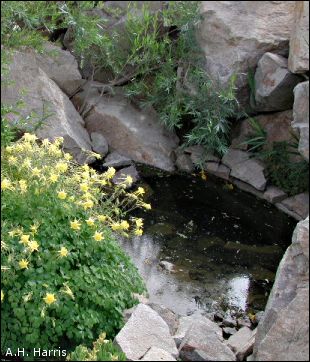

Throughout our desert, occasional pools of water emerge from the nether regions. To the thirsty hiker, these appear as a gift from on high. But beware! Despite the unconsidered opinions of TV, radio, and print media, all that is natural is not benign.
That clear sparkling water may be spiked, not with alcohol, but with such dissolved goodies as arsenic, lead, or selenium—all poisonous to humans. The alchemists of yore searched for the universal solvent in vain, but the next best thing is water. Minerals galore will dissolve in water under the right conditions, giving no hint to the naked eye of their presence. Although most known mineral-poisoned springs lie in other regions, this may reflect the scarcity of research rather than fact.
Material leached from the ground is not the only danger. That innocent
looking pool may be teeming with invisibly small, but potentially deadly,
microorganisms. Not all dangers are invisible—water often means mosquitoes, and
mosquitoes spread such diseases as dengue fever and encephalitis. Eternal vigilance
relates both to liberty and to living with nature.

Contributor: Arthur H. Harris, Laboratory for Environmental Biology, Centennial Museum, University of Texas at El Paso.
Desert Diary is a joint production of the Centennial Museum and KTEP National Public Radio at the University of Texas at El Paso.
<<img class="rule" src="ruleahh.gif" width="95%" height="2" alt="rule" />
A hueco: a depression in the rocks that holds water. In this case, it's part of the Chihuahuan Desert Gardens, but wherever found, not to be trusted for drinking. Photograph by A.H. Harris.